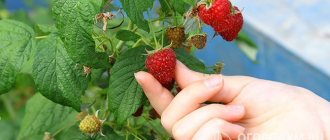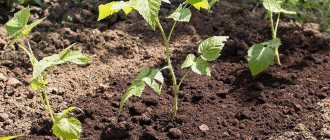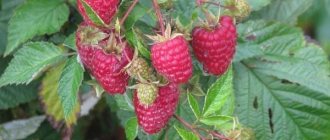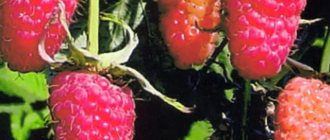Large-fruited raspberry varieties, adapted to various weather conditions, are especially popular among Russian gardeners, given the country’s vast geography and variety of climatic zones.
One of these promising varieties is the Pride of Russia raspberry.
This hybrid was bred in 1992 by the Russian breeder of the Moscow VSTiPS - Viktor Valeryanovich Kichina. The donors for the new variety were: the “Stambovy-20” variety, characterized by great growth potential and viability of the bush, and the “Stolichnaya” raspberry variety, which transferred the high commercial qualities of the berries to the new hybrid.
Description of the variety
- Raspberry Pride of Russia is a large-fruited, mid-early, non-repairing variety that produces one harvest per season. The first berries begin to ripen from the end of June or the beginning of July, it depends on the weather and the region. The harvest is harvested in 5-6 stages per season. Berry picking ends in early or mid-August. The variety is characterized by high productivity. Cultivated in the southern regions, in central Russia, the Urals, and Siberia. The variety is self-pollinating;
You might be interested! Description of the most popular variety of 2016 - Caramel raspberry.
- The shrub has a powerful root system and produces up to 10-12 replacement shoots per season. The main shoots are erect, strong, grow up to 170-190 cm in length. The bush has no thorns, the waxy coating is weakly expressed. The shoots bear fruit the following year. Up to 10-12 fruit branches are formed in the leaf axils, which bear up to 18-20 berries;
- The leaves are large, dark green in color, corrugated in appearance, covered with a small fluff on top, and gathered into a rosette at the end of the stem;
- The berries at the time of full ripeness are red or pale red in color, very large, their average weight is 8-12 grams; with professional agricultural technology, the berries can weigh up to 15-20 grams. They are elongated conical in shape, blunt at the cone, tuberous. In bad weather conditions, duplicate specimens are found. The yield of the variety is 5-6 kg. berries from the bush;
- The pulp is tender, juicy, sweet and sour in taste, the drupes are large, tightly pressed to each other, the seeds are very small. When picked, the berries do not flow, do not wrinkle, are easily removed from the stalk, but do not tolerate long-term transportation. The harvested crop can be stored for no more than a day;
- Raspberry Pride of Russia winters well. It tolerates frosts down to -30 C, but the shoots need to be bent to cover with snow. Tolerates heat and dry winds well. The berries are not baked or crushed. The variety is genetically determined to be resistant to diseases common to most varieties of raspberries. Among the pests, the plant is sometimes attacked by aphids.
With insufficient feeding, as well as in rainy summers or in the shade, the berries do not accumulate sugar well, so they can be sour and without aroma.
a brief description of
Advantages of the variety
- large, tasty fruits;
- high productivity;
- absence of thorns;
- self-fertility;
- ability to produce good harvests in different climatic zones;
- resistance to most diseases and pests.
Disadvantages of the variety
- average transportability of berries;
- vulnerability to sudden changes in air temperature;
- When there is insufficient light, the sugar content and aroma of the berries are reduced.
Disadvantages of Pride of Russia
Even the most popular variety has at least a few disadvantages, among which are:
- Sensitivity to soil composition and watering.
- With a lack of sunlight and prolonged rains, the berries lose their taste and attractiveness and very often double.
- The culture is demanding on fertilizing.
- In regions with a significant decrease in temperature, shelter is needed.
More on the topic: Ordinary raspberry variety Ozarenie
Like all large-fruited raspberries, the Giant needs to follow the basic rules of agricultural technology, otherwise you may not see abundant harvests and especially large berries.
Landing
It is better to plant Pride of Russia raspberries in the spring in the northern regions; the spring there is not hot, long, and under such conditions it is easier for the seedling to take root.
It is important to remember that in the spring it is better to plant cuttings without leaves, when the buds on them are just beginning to awaken.
In autumn, it is better to plant raspberries in the south. Autumn there is warm and long, the seedling has time to take root before the cold weather. It is important that young shoots do not begin to appear; they will not have time to get stronger and will freeze in winter.
Cuttings from pots or fresh root shoots with soil can be planted throughout the season.
The main points of planting raspberries are the same for most varieties: gardeners use the bush or strip method of propagating raspberries, when holes or trenches are dug in rows for the cuttings.
In order for the Pride of Russia raspberry to realize all its declared qualities, the following conditions are necessary:
- a site for raspberries should be allocated in a well-lit, sun-warmed place, on a hill or on a slope, where there is no nearby groundwater;
- the soil on the site needs to be dug up, cleared of weeds and debris;
- heavy clay soil needs to be dug up with peat, sand, humus, and fertilizers. Sandy soil, on the contrary, should be mixed with clay so that the soil retains moisture. Neutralize the acidity of the area with lime, wood ash or old cement. Remove ants if possible;
- fill holes or ditches 45-50 cm deep with one-third filled with soil mixed with fertilizers (manure or bird droppings, compost, wood ash, potassium-phosphorus composition).
The area for raspberries must be prepared 15-20 days before planting, so that the soil has time to settle and the fertilizers are absorbed.
Cuttings of large-fruited raspberry varieties are planted at a distance of 1-1.2 m from each other, leaving a distance between rows of 2-2.5 m. The roots of the cuttings are spread over the top of the nutrient mixture, covered with garden or forest soil, and watered at the rate of 20 liters. water per bush. The cuttings are cut so that no more than 3-5 viable buds remain on it, and the planting site is mulched with sawdust or straw.
It is important to know that sawdust from coniferous trees strongly acidifies the soil, so they are not used in agricultural technology.
Without waiting for the bushes to grow, you need to install supports for gartering raspberries. Since the berries of this variety lose their taste when there is insufficient sunlight, it is better to equip trellises with wire for gartering. It is believed that with such a garter, the bush produces and retains twice as many berries as one simply tied to posts, or not tied at all.
How to reproduce?
This variety has good survival rate. Reproduction does not require much effort. There are several methods of reproduction:
- seminal;
- root suckers;
- dividing the bush;
- cuttings;
- root cuttings.
The seed method is used extremely rarely. This is due to the laboriousness of the process and the possibility of loss of varietal characteristics. When propagating by root suckers, it is enough to dig up a shoot that has reached 15 cm and plant it in a prepared place.
Root cuttings are prepared in early spring. To do this, dig up the root, divide it into pieces of 10-15 cm (each cutting should have a bud), and plant it in loose soil. In autumn, young seedlings appear at the planting site.
The most popular method is cuttings. To obtain a seedling from a cutting you need:
- Cut off a shoot 10-15 cm long.
- Place it in the root-forming solution for 12 hours.
- Plant in a pot with nutritious soil at an angle of 45 degrees.
- Water and cover with film.
- After rooting, transplant to a permanent place.
Features of care
Watering
For raspberries, it is necessary to saturate the soil with moisture to a depth of 40-45 cm. Based on this, you need to regulate the watering of the raspberry tree: take into account the amount of melt water in the spring, the structure of the soil, the nature and frequency of rains. The variety is large-fruited and productive, therefore it consumes a lot of water. Abundant watering - 30-40 l. water per bush will be simply necessary for raspberries during flowering, as well as at the time of growth and ripening of the berries. In the southern regions, Pride of Russia raspberries need to be watered abundantly even after the last harvest, in order to nourish the plant after fruiting and support it in the September heat.
However, waterlogged soil can lead to rotting of the roots, and the berries will be watery and not sweet.
Trimming
Pride of Russia produces a lot of basal shoots and up to 10-12 replacement shoots. To prevent thickening of the bush and spreading of shoots throughout the area, you need to regularly cut out the shoots while weeding. In the fall, it is also necessary to cut out all dry, damaged, weak branches. For the next season, it is enough to leave 5-7 new, healthy, non-fruiting shoots. In the spring, frozen stems are cut out and the tops of last year's branches are pinched to activate the formation of fruit branches.
Top dressing
If the required amount of fertilizer was applied to the site and to the bottom of the holes before planting, then the raspberry tree does not need to be additionally fed for the first 2-3 years. Excess fertilizers deplete the soil and spoil the quality of the berries. During this time, you can prepare compost pits, bring in manure, peat or forest soil. Starting from 3-4 years after planting, organic and mineral fertilizers are applied 2-3 times per season.
Preparing for winter
For areas of central Russia, the northern regions, it is recommended to remove raspberry bushes from the trellises, tilt them to the ground, fixing them to the bottom row of wire. This must be done before the onset of cold weather, while the shoots are flexible. If winters have little snow, you need to cover the ground under the bushes with a thick layer of straw or any other mulch.
Reproduction
Pride of Russia raspberries are propagated by root shoots, rooting the upper part of the shoots, and cuttings from healthy shoots are also grown in greenhouses for subsequent planting on the site.
Disease and pest control
The variety is genetically resistant to a number of common diseases.
Table: diseases, prevention and treatment
| Diseases | Symptoms | Prevention | Treatment |
| Anthracnose | Necrotic spots are visible on the foliage and stems, and the fruits shrivel. Long rains contribute to the occurrence of the disease. The disease can lead to significant crop losses. | Remove fallen leaves and regulate watering. | Before the buds emerge, spray with Nitrafen (300 g/10 l). |
| Septoria | The disease is severely manifested in damp weather. Light spots with a brown border form on the foliage, and the leaves dry out. | Do not thicken the plantings, do not flood them. |
|
| Rust | Orange formations resembling rust appear on the leaf blade. Annual shoots become covered with ulcers. |
|
|
| Powdery mildew | A dirty white coating forms on the bark, leaves and shoots. Foliage falls and productivity decreases. |
|
|
Photo gallery: raspberry diseases
With anthracnose, necrotic spots appear on shoots and leaves
Septoria blight affects stems and leaves
Increased humidity promotes the development of rust; the disease does not progress during drought.
The foliage of a plant affected by powdery mildew becomes covered with a white coating.
Table: pests, prevention and control measures
| Pests | Manifestations | Prevention | Measures |
| Raspberry-strawberry weevil | The larvae chew out the bud, thereby weakening the flowering. Beetles eat leaves. |
| Spray in the green cone phase with Fufanon (10 g/10 l). |
| Raspberry fly | The larvae gnaw through the stems, the branches turn black and die. | In the fall, dig up the soil. | After flowering, spray with Iskra (1 ml/5 l), Aktara (2 g/10 l), again after 7 days. |
| Raspberry beetle | The beetle feasts on leaves and buds, while the larvae feed on the pulp of ripe fruits. The pest can destroy up to 50% of the crop. |
|
|
Photo gallery: raspberry pests
The weevil damages the buds, which leads to reduced fruiting
Stems damaged by raspberry flies, starting from the top, wither, turn black, rot and die
The raspberry beetle and its larvae can destroy most of the crop
Video: damage to bushes by raspberry fly
Reviews
In the second year after planting, our “Pride of Russia” bushes gave an excellent harvest - up to 4 kg per bush. Although they write that it gives a full harvest in 3-4 years. We have 20 bushes growing, in the future we want to increase this number by 2 times. The variety is very large-fruited, everyone liked the taste of the berries, but they are poorly stored, they need to be eaten or processed immediately.
The berries have grown large and bright, but they are tasty only when they ripen in the sun. The bushes that grow behind our building gave a rich harvest, but the berries taste sour. We will leave the Pride of Russia raspberries. We will multiply.
Any business that is done with soul and passion always gives a good result. By carrying out simple agrotechnical measures for growing Pride of Russia raspberries, you will receive not only a generous harvest, but also useful experience, health and satisfaction.











